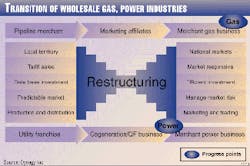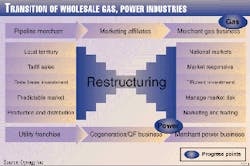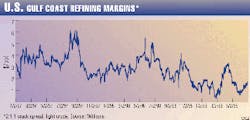Energy companies are adjusting their business plans to respond to rapid and profound changes in the businesses in which they operate.
Integrated energy firms are reacting to growing deregulation in electricity markets and convergence of the natural gas and electric power businesses. Independent petroleum companies, meanwhile, are trying to respond to recovery in the oil market while still ailing from the effects of the extended downturn.
The leaders of selected energy companies spoke about their plans at Banc of America Securities LLC`s first energy conference, held in Houston late last month. Most appeared optimistic about the future, due to expected growth in gas and power demand and growing confidence in the current industry revitalization.
Deregulation
Integrated energy firms are looking to the spread of power deregulation as the source for future growth.
"North American deregulated energy markets are changing dramatically, growing rapidly," said Kenneth D. Rice, CEO of Enron Capital & Trade Resources Corp.
Ten years ago, Enron was in the natural gas wholesale business, he said. Now, the company is in the wholesale gas and power and retail energy services businesses, among many others.
Daniel L. Tulis, managing director of Banc of America Securities` diversified energy group, sees the changes under way in the gas and electricity businesses as unprecedented in scope: "We believe there will be relatively few companies that will be successful in this area, given the high capital and risk necessary to compete."
Enron`s plan for meeting the challenges of the shifting industry landscape including expanding its gas business to support its investments in the power sector.
"These two commodities are evolving into a BTU-related market," said Rice.
In the next 3-5 years, almost every state in the U.S. will have at least some form of retail access, he predicts. And it is essential for companies competing in this sector to have a balanced gas-power portfolio.
During the next 3-4 years, there will probably be 1 tcf/year of incremental gas demand in the U.S. due to new power plants, says Rice. Enron will respond to this by increasing the interaction between its gas and power grids so that gas can be moved around its network to meet peak power demand.
"Our power business is the main growth driver of Enron Capital & Trade Resources," said Rice. "We`re supplementing our existing network with very flexible, strategically located generating assets."
Dynegy Inc. Chairman and CEO Chuck Watson is also looking to power deregulation as a source of opportunity.
"I am confident that the (power) business will act and react like the gas business...," he said (see Fig. 1). "Energy convergence maximizes the value of marketing and trading opportunities in wholesale natural gas, power, and coal, which are centered around the control and optimization of BTU conversion capacity and other assets."
Another way deregulation will play out in the power industry is to spawn rapid growth in the energy services industry.
"There`s going to be a huge demand for new types of products and servicesellipsea tremendous explosion...," said Rice.
Watson agrees. He believes energy services contracts, such as those in which a company controls or manages another firm`s assets, are about to "skyrocket."
Rice has a precise view of the future of new products and services. Billing will change such that the customer knows exactly what he or she is paying for, he says. And, with new risk-management products, a consumer will be able to contract with a supplier to pay a fixed fee-$100/month, for example-regardless of changes in prices or usage. In addition, gas and electricity may be bundled products, says Rice.
Capital spending rebound
In the more traditional petroleum sector, companies are still reticent about reacting too strongly to the upswing in oil markets.
While a few, such as Coastal Corp., have recently announced increases in their 1999 capital budgets (OGJ, July 5, 1999, Newsletter), many are adopting a wait-and-see policy.
Coastal Pres. and CEO David Arledge told analysts at the Banc of America Securities meeting, "We have recently received board approval to increase the 1999 capital budget by $300 million." Some of the increase will be spent on acquisitions, but development spending will also rise.
Gas developments are critical if the industry is to meet the demands of a U.S. gas market that is expected to grow to 30 tcf/year by 2010.
Coastal`s plan centers on finding and developing additional gas supplies and positioning its assets to move that supply to market.
"We believe that, at every segment of the gas value chain, there is an opportunity for profitable growth," said Arledge. "It is essential that we find additional (gas) reserves and additional deliverability."
Less sanguine about the possibility of a 30 tcf U.S. gas market is Keith Bailey, chairman, CEO, and president of Williams. Bailey says it`s possible, "but it`s going to take an alignment of the planets."
Meridian Resource Corp. is taking a more conservative approach than Coastal.
Chairman and CEO Joseph Reeves says his company has cut over $100 million from its 1999 budget compared with 1998 but has continued to achieve "significant" reserves growth through the drillbit in the last 9 months.
"What we have (planned) for the balance of this year is more of a development/exploitation (strategy) going forward," said Reeves. This is a low-cost, low-risk strategy that will still enable Meridian to increase production, reserves, and cash flow.
"In the next 6 months, 98% of what we`re going to be drilling is development," said Reeves.
While many in the industry are worrying about not reacting too quickly to the recovery, Anadarko Petroleum Corp. Pres. and COO John Seitz believes companies responded to rapidly, and too dramatically, to the price fall.
"In the recent low oil price cycle, more than 100,000 (people) in the E&P and service sector lost their jobs," said Seitz. "Our industry lost valuable experience that we will never get back.
"Over the next few quarters, I think you`ll see budgets and drilling programs ramp up again. It`s happening right now as I speak, but that takes people."
Refining
As markets return to normal, the downstream sector is also feeling a little more optimistic about the future.
Following a fairly steady decline in refining margins over the last 2 years (Fig. 2), Arledge says he is seeing early signs of a downstream recovery.
Refiners are beginning to increase their crude runs, so the stock overhang will begin to fall. As a result, Arledge expects a small improvement in refining margins by the end of 1999 and a further increase in 2000.
But, like most firms, Coastal isn`t letting up on its push to cut costs. It has increased its crude runs in order to reduce per-barrel costs, says Arledge. And, to further trim costs, the firm is adding a coker at its Aruba refinery. This will enable the plant to process up to 100,000 b/d of heavy Maya crude from Mexico, under an arrangement with Pemex (OGJ, Aug. 10, 1998, News- letter).
For the future, says Arledge, Coastal will continue to seek joint ventures, processing arrangements, and other agreements for its refineries.
Valero Energy Corp. is also embarking on a cost-reduction strategy.
Vice-Pres. and CFO John Gibbons says Valero aims to reduce operating costs by $50 million/year by 2002. Among its goals are reduced use of contract maintenance, improved reliability, and reduced energy consumption. Capital investments for 1999 have been cut by 30% from 1998 levels, to $150 million.
"What we`re seeing is an enormous inventory overhang in both distillates and gasoline," said Gibbons. "...With the OPEC cuts, crude prices have risen, but...margins have not risen as quickly.
"Distillate demand is down 4-6% (so far) this year. Gasoline demand continues to be strong, with over 2% growth this year over last year."
"The only good thing about weak margins," said Gibbons, "is that they reduce capacity creep. This is probably the first year we`ve had in a long time where capacity creep has not outpaced demand."


